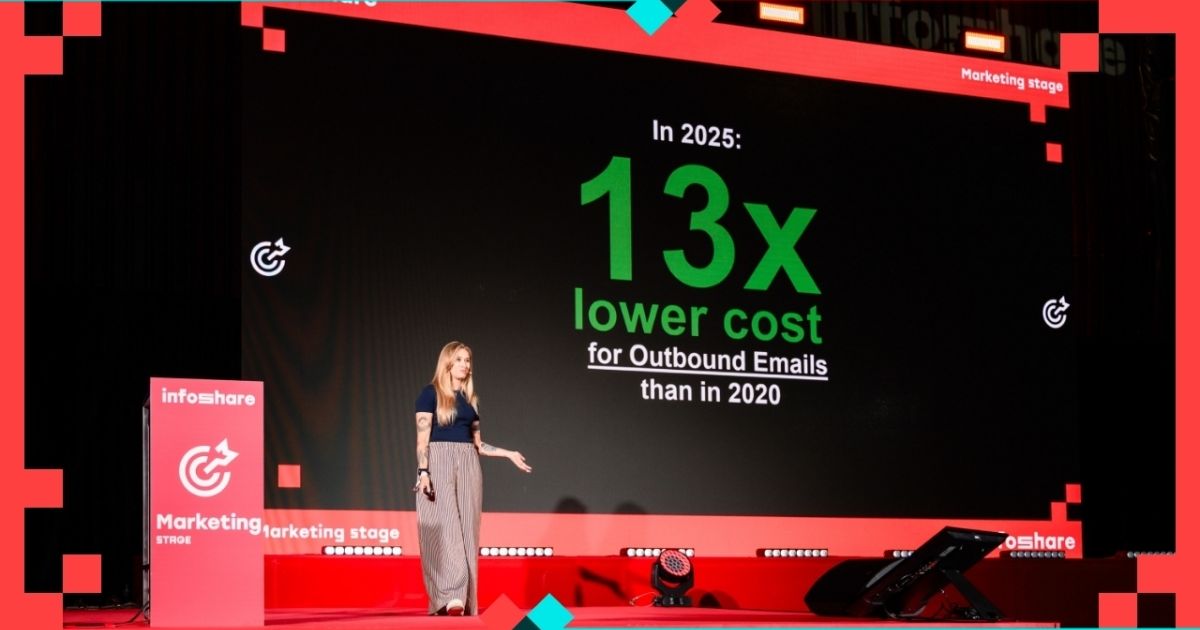VIEW SPEECH SUMMARY
Cost and Efficiency of Cold Emailing in 2025
- Customer acquisition remains challenging; cost comparison among channels provided.
- Cold emailing costs dropped significantly since 2020—from about $5,500 to $400 for 10,000 prospects.
- This reduction is attributed to data commoditization and AI tools.
- Cold emailing is now more affordable and worth considering for generating leads.
Understanding Leads in Cold Emailing
- Leads defined as positive replies to value propositions, not just clicks or views.
- Cold emailing allows person-to-person communication, unique compared to other channels.
Case Studies and Results from Various Markets
- US Market: 8K prospects, 30% response rate, over 1K positive leads.
- Germany & Logistics: 12K prospects, 13% response rate, 121 leads.
- Education Sector: 5K prospects, 43% response rate, 457 leads.
- Micro Campaign Example: 46 prospects, 27 positive replies on paid/unpaid partnerships.
- Software Sector: 600 prospects, 30% response rate, 25 leads.
Return on Investment (ROI) Calculations
- Example: 10,000 prospects, 3% reply rate, 10% positive conversion, $2K deal size.
- Cost per lead approx. $28; $1 spent returns $6.
- Strong campaigns yield better ROI: $1 spent can return $32 to $119.
- Summary tables available upon LinkedIn request.
Five Pillars to Successful Outbound Campaigns
1. Deliverability
- Ensure emails reach the inbox, not spam.
- Use multiple domains and mailboxes (max 3 per domain) to scale horizontally and maintain deliverability.
- Deliverability requires building trust over time; it is a continuous, predictable process.
- Plan infrastructure with backups and varied email providers.
- Utilize provided planner (QR code) to manage infrastructure and backups.
2. Offer Market Fit
- Match your offer to the right audience; selling irrelevant solutions fails.
- Understand problem-solution fit for your target market.
3. Copywriting
- Keep emails short (50-100 words) and focused.
- Use proven frameworks (e.g., PASS) and tools like ChatGPT to craft messages.
- Avoid complex jargon and buzzwords ("synergize," "leverage") to improve engagement.
4. Strategy
- Define clear campaign goals (number of customers desired).
- Plan research, setup, launch, and timing of outreach.
- Use 2-4 email sequences with varied angles to avoid spamming and maximize touchpoints.
5. Iterations
- Give yourself space to experiment with audiences, angles, CTAs, and messaging.
- Collect data and refine offers based on feedback.
- Avoid narrow approaches; scale and diversify for better learning.
- Recognize cold emailing is a volume game needing persistence beyond a few days or emails.
Final Thoughts and Encouragement
- Cold emailing is more like paid ads than newsletters—an acquisition channel focused on generating customers.
- It’s not easy but manageable with effort and time.
- Persistence is key; do not give up after initial failures.
- Cold emailing is currently one of the cheapest and best supplementary channels for customer acquisition.
Actionable Items / Tasks:
- Connect with Smoko Zata on LinkedIn for questions, campaign summary tables, or free T-shirt.
- Use the deliverability planner to prepare outbound email infrastructure and backups.
- Ensure outbound campaigns use multiple domains and mailboxes for scale and deliverability.
- Define your campaign goals clearly before launching outreach.
- Use copywriting frameworks and keep messages short and simple.
- Design email sequences of 2-4 messages with varied hooks and CTAs.
- Allow space for data-driven iterations, testing different segments and messages over time.
- Be patient and persistent; send sufficient volume to gather meaningful insights.
- Customer acquisition remains challenging; cost comparison among channels provided.
- Cold emailing costs dropped significantly since 2020—from about $5,500 to $400 for 10,000 prospects.
- This reduction is attributed to data commoditization and AI tools.
- Cold emailing is now more affordable and worth considering for generating leads.
Understanding Leads in Cold Emailing
- Leads defined as positive replies to value propositions, not just clicks or views.
- Cold emailing allows person-to-person communication, unique compared to other channels.
Case Studies and Results from Various Markets
- US Market: 8K prospects, 30% response rate, over 1K positive leads.
- Germany & Logistics: 12K prospects, 13% response rate, 121 leads.
- Education Sector: 5K prospects, 43% response rate, 457 leads.
- Micro Campaign Example: 46 prospects, 27 positive replies on paid/unpaid partnerships.
- Software Sector: 600 prospects, 30% response rate, 25 leads.
Return on Investment (ROI) Calculations
- Example: 10,000 prospects, 3% reply rate, 10% positive conversion, $2K deal size.
- Cost per lead approx. $28; $1 spent returns $6.
- Strong campaigns yield better ROI: $1 spent can return $32 to $119.
- Summary tables available upon LinkedIn request.
Five Pillars to Successful Outbound Campaigns
1. Deliverability
- Ensure emails reach the inbox, not spam.
- Use multiple domains and mailboxes (max 3 per domain) to scale horizontally and maintain deliverability.
- Deliverability requires building trust over time; it is a continuous, predictable process.
- Plan infrastructure with backups and varied email providers.
- Utilize provided planner (QR code) to manage infrastructure and backups.
2. Offer Market Fit
- Match your offer to the right audience; selling irrelevant solutions fails.
- Understand problem-solution fit for your target market.
3. Copywriting
- Keep emails short (50-100 words) and focused.
- Use proven frameworks (e.g., PASS) and tools like ChatGPT to craft messages.
- Avoid complex jargon and buzzwords ("synergize," "leverage") to improve engagement.
4. Strategy
- Define clear campaign goals (number of customers desired).
- Plan research, setup, launch, and timing of outreach.
- Use 2-4 email sequences with varied angles to avoid spamming and maximize touchpoints.
5. Iterations
- Give yourself space to experiment with audiences, angles, CTAs, and messaging.
- Collect data and refine offers based on feedback.
- Avoid narrow approaches; scale and diversify for better learning.
- Recognize cold emailing is a volume game needing persistence beyond a few days or emails.
Final Thoughts and Encouragement
- Cold emailing is more like paid ads than newsletters—an acquisition channel focused on generating customers.
- It’s not easy but manageable with effort and time.
- Persistence is key; do not give up after initial failures.
- Cold emailing is currently one of the cheapest and best supplementary channels for customer acquisition.
Actionable Items / Tasks:
- Connect with Smoko Zata on LinkedIn for questions, campaign summary tables, or free T-shirt.
- Use the deliverability planner to prepare outbound email infrastructure and backups.
- Ensure outbound campaigns use multiple domains and mailboxes for scale and deliverability.
- Define your campaign goals clearly before launching outreach.
- Use copywriting frameworks and keep messages short and simple.
- Design email sequences of 2-4 messages with varied hooks and CTAs.
- Allow space for data-driven iterations, testing different segments and messages over time.
- Be patient and persistent; send sufficient volume to gather meaningful insights.
How to acquire customers with outbound emails in 2025
11:30 - 11:50, 27th of May (Tuesday) 2025 / MARKETING STAGE
Based on 55+ million outbound emails sent by our customers
In this talk I will explain why outbound emails are effective as a customer acquisition channel. I will compare how outbound emails perform against other acquisition channels like paid ads or SEO. And I will show what are are the elements of a successful outbound email campaign in 2025 (spoiler alert: what worked for outbound emails in 2020 does not work in 2025)
LEVEL:
Basic
Advanced
Expert
TRACK:
Business Strategy



